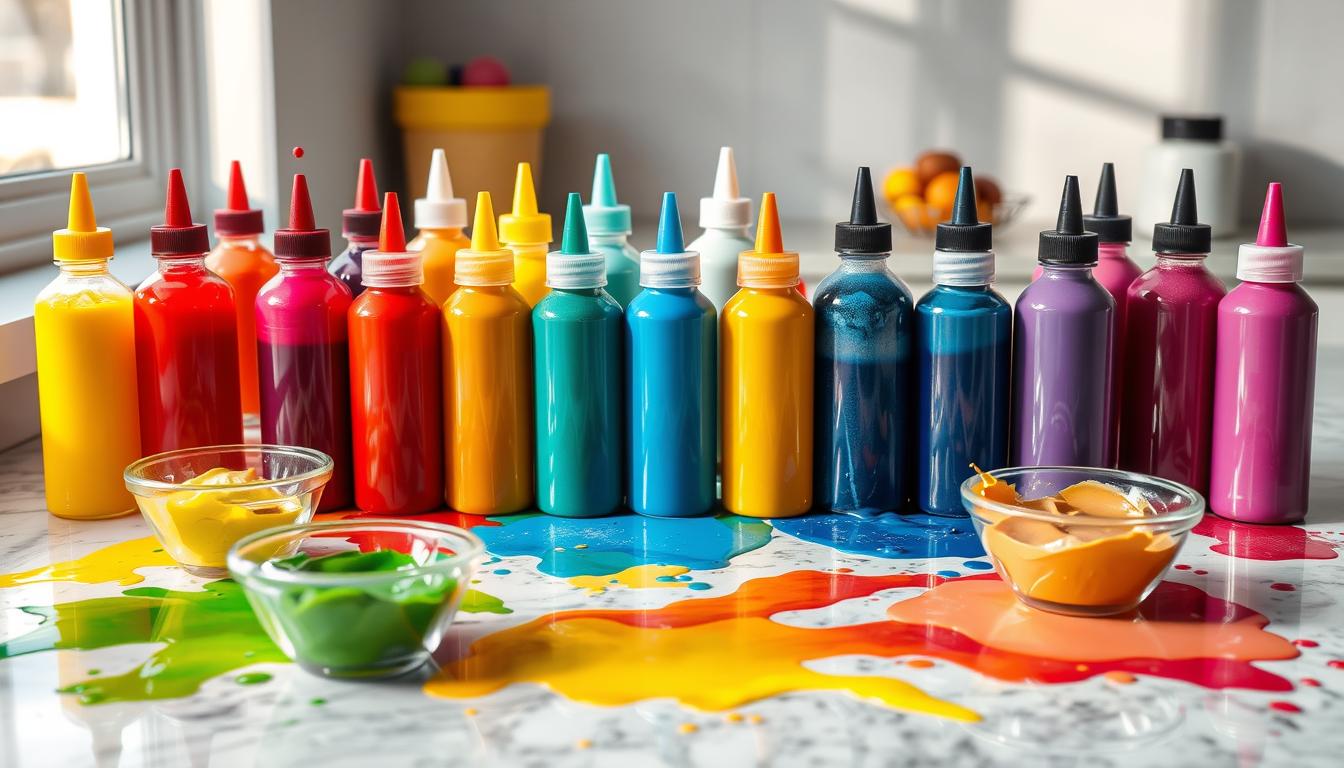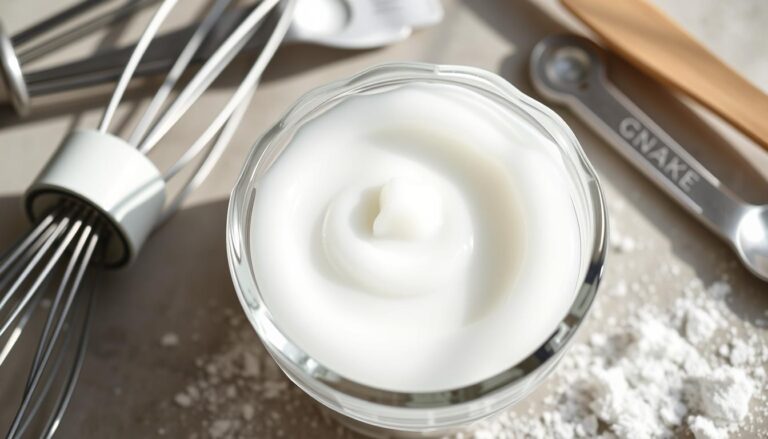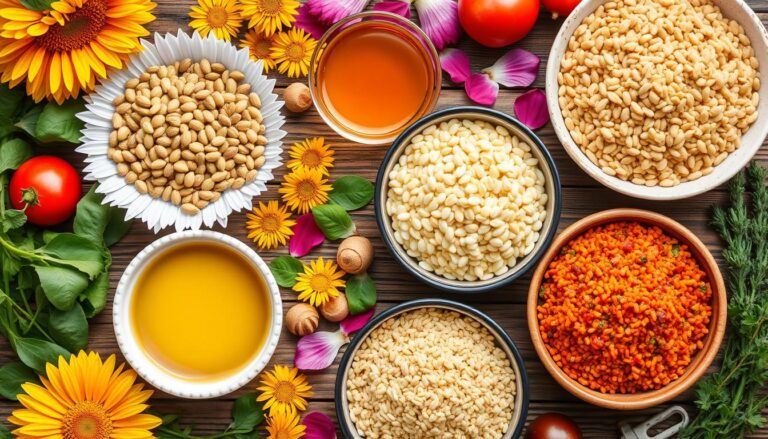Choosing the Right Cake Food Coloring: A Baker’s Essential Guide
As a home baker, I love how cake food coloring changes my desserts. It makes them look amazing and brings joy to my baking. Whether it’s a fancy cake or colorful macarons, the right food coloring is key.
In this guide, I’ll share my knowledge on cake food coloring. We’ll talk about gel paste, oil-based vs. water-based, and more. We’ll find the best coloring agents to make your baked goods look and taste great.
Table of Contents
What is Gel Paste Food Coloring?
Gel paste food coloring is a concentrated coloring agent. It has a thick, gel-like consistency. This makes it easy to blend into batters and frostings.
It produces vibrant colors, unlike liquid food coloring which can give pastel shades. Gel paste also lasts longer, saving money for frequent users.
Traditional Liquid Food Color vs. Gel Paste Food Color
Liquid food coloring is cheaper but less concentrated than gel paste. Liquid gel food coloring is a favorite among professional bakers. It’s concentrated and quick to use.
Gel food coloring, or gel paste, is also concentrated. It gives rich colors but takes longer to develop.
The Benefits of Gel Paste Food Coloring
Gel paste food coloring has many benefits. Its concentrated formula means you use less to get bright colors. The gel-like consistency makes blending easy without changing the texture.
It lasts longer than liquid food coloring, saving money. Gel paste is also versatile. It works well in frosting, icing, fondant, and gumpaste.
“Gel paste food coloring is a highly concentrated coloring agent that produces more vibrant and true colors than liquid food coloring.”
When to Use Gel Paste Food Coloring
Gel paste food coloring is a must-have for bakers. Because it’s so concentrated, a small amount goes a long way.. It’s great for coloring buttercream, frosting, fondant, gumpaste, and even cake batters.
The gel paste’s thick, creamy texture gives amazing color. It creates bright, true colors that liquid food colorings can’t match. This makes your baked goods pop with bold, eye-catching shades.
Gel paste also lasts longer than liquid food coloring. This means you get more use out of it, saving you money in the long run.
Coloring Buttercream, Frosting, Fondant, and Gumpaste
Gel paste is perfect for coloring buttercream, frosting, fondant, and gumpaste. Its thick formula lets you get deep, rich colors. These colors will make your cakes, cupcakes, and desserts look amazing.
Coloring Cake Batters
Gel paste is also great for cake batters. It keeps the color vibrant, whether you’re making a red velvet cake or an ombre design. The intense pigmentation ensures your batter stays bright.
“For bakers who wish to include striking, vivid colour into their creations, gel paste food colouring is a game-changer. Its concentrated formula and long-lasting properties make it a must-have in any well-stocked baking pantry.”
Tips and Tricks for Using cake food coloring
Start with a Small Amount
When using gel paste food coloring, start with a small amount. Add more gradually until you achieve the desired hue. These colors are very strong, so a little is enough.
Use a clean toothpick to mix the gel paste into your batter or frosting. You can always add more color if needed. But fixing an overly colored mix is harder.
Mixing and Blending Techniques
To mix the color evenly, use a spatula or electric mixer. This ensures the color is spread out well in your batter or frosting. It’s also important to mix well to get a consistent color.
Wearing gloves is a good idea when using gel paste food coloring. The colors can stain your hands.
For rich, vivid colours, gel food colouring works wonders. It doesn’t change the consistency of your mix. Liquid food coloring is better for lighter colors, like pastels. Powdered food coloring is the most concentrated and is best for dry ingredients.
| Type of Food Coloring | Concentration | Best Use |
|---|---|---|
| Gel Food Coloring | High | Deep, vibrant hues without affecting consistency |
| Liquid Food Coloring | Low | Lighter pastel colors in icings, beverages, and dough |
| Powdered Food Coloring | Highest | Dry applications to avoid adding moisture |
For vibrant colors, try AmeriColor, Wilton, or Chefmaster. Start with a small amount of coloring. This helps avoid over-coloring. Mixing well is key to avoid streaks and uneven colors in your cakes.
“Gel paste food colouring is the most commonly used form of food colouring in the baking and cake decorating world.”
The Ingredients in Gel Paste Food Coloring
Gel paste food coloring is a favorite among bakers and cake decorators. It’s known for its bright colors and versatility. But what makes it special? Let’s explore the main ingredients in gel paste food coloring.
The main parts of gel paste food coloring are water, sugar or corn syrup, glycerin, and food coloring. These mix together to give gel paste its thick texture and deep colors. This makes it different from regular liquid food colorings.
- Water is the base, blending the other ingredients together.
- Sugar or corn syrup adds sweetness and keeps the formula stable. It prevents separation and ensures a smooth texture.
- Glycerin keeps the gel paste moist. It helps it stay soft and pliable.
- Food coloring is what gives gel paste its bright colors. It’s the main attraction for bakers.
Even though different brands might have slightly different formulas, these core ingredients are what make gel paste special. They give it unique properties that make it useful in baking and cake decorating.
| Ingredient | Function |
|---|---|
| Water | Base for the formula |
| Sugar or Corn Syrup | Adds sweetness and stability |
| Glycerin | Humectant to prevent drying |
| Food Coloring | Provides the vibrant hues |

“Gel paste food coloring is a game-changer for bakers who want to achieve bold, vibrant colors in their creations.”
Why Choose Gel Paste Over Other Types of Food Coloring?
Gel paste food coloring is the top pick for adding bright, real colors to baked goods. It’s very concentrated, so you only need a little to get the color you want. This doesn’t mess with the texture of your cakes, frostings, and other treats.
The gel paste’s thick texture makes it easy to control and mix. It’s perfect for delicate desserts like macarons and meringues. You can keep the texture right without adding too much moisture.
Gel paste food coloring also lasts a long time without losing its color. Unlike liquid dyes, it stays vibrant for a long time. This makes it a smart choice for those who use food coloring often.
- Highly concentrated formula allows for vibrant, true-to-life colors with smaller amounts
- Thick, gel-like consistency provides better control and easier blending
- Longer shelf life for more economical and practical use
- Versatile in a wide range of baking and decorating applications
Gel paste food coloring is also very versatile. You can use it to color frostings, batters, fondant, and gumpaste. This makes it a key tool for creating stunning cakes and desserts.
Whether you’re a pro cake decorator or a home baker, gel paste food coloring is a great choice. It offers vibrant colors, a thick texture, and lasts a long time. It’s a must-have for any kitchen.
Exploring Different Types of Cake Food Coloring
Choosing the right food coloring is key to vibrant colors in your baked goods. Cake bakers have many options, each with special properties. Let’s look at oil-based and water-based coloring, and natural alternatives.
Oil-Based vs. Water-Based Food Coloring
Oil-based coloring is great for rich desserts like chocolate and buttercream. It dissolves well in oils, adding color without changing texture or taste. Water-based coloring works best for light treats like meringues and jellies. It mixes well with water without changing the dessert’s consistency.
Natural Food Coloring Options
Natural coloring from plants like beet root and turmeric is good for health-conscious bakers. These options might not be as bright, but they’re a natural way to add color to cakes and desserts.
Knowing about different colorings helps you choose the best for your baked goods. This ensures your creations are both beautiful and delicious.

“Gel paste food coloring is my go-to for achieving rich, vibrant hues in my cakes and buttercreams. The concentrated formula allows me to use just a small amount to create a big impact.”
– *Sarah, professional baker and cake decorator*
Cake Food Coloring Brands and Recommendations
There are many great brands for cake food coloring. Americolor, Roxy & Rich, and Chef Master are top picks. They offer gel paste food colorings that are very concentrated. These colors can make your cakes look amazing.
Chefmaster and Sugar Flair are also favorites. They have both gel paste and liquid food coloring. This means bakers can pick the best type for their needs, whether it’s bold colors or soft pastels.
Brands like Americolor, Sugar Flair, and Chefmaster also have natural and kosher options. This is great for those who want healthy baking without losing color quality.
| Brand | Product Type | Certifications |
|---|---|---|
| Americolor | Gel Paste, Liquid | Kosher |
| Roxy & Rich | Gel Paste | – |
| Chef Master | Gel Paste, Liquid | Kosher |
| Colour Mill | Gel Paste | – |
| Sugar Flair | Gel Paste, Liquid | Kosher |
| Chefmaster | Gel Paste, Liquid | Kosher |
Choosing the right cake food coloring brand is important. Think about the color you want, how you’ll use it, and any dietary needs. By looking at what these trusted brands offer, you can make cakes that are not just delicious but also beautiful.
Cake Food Coloring: Adding Vibrant Visual Appeal
As a baker or cake decorator, you know how important looks are. Cake food coloring is key for adding bright colors to your baked goods. It turns simple cakes into stunning art.
Looking for bold colors or soft pastels? The right cake food coloring makes a big difference. You can color batter, create rainbow layers, or ombre effects. The possibilities are endless.
Gel-based food colorings are popular for their bright, concentrated colors. They work well in many recipes. Liquid food coloring gives lighter shades, while powdered food coloring is great for dry applications.
Getting the perfect cake color requires the right techniques and tools. From mixing colors to airbrushing, you can create stunning cakes. It’s all about experimenting and mastering your craft.
Cake decorating stars like Katherine Sabbath and Cake Stone 20 inspire us with their vibrant cakes. They show us how to use cake food coloring to make our baked goods stand out. Follow their lead and amaze your customers or loved ones with your creations.

| Type of Food Coloring | Characteristics | Best Uses |
|---|---|---|
| Gel Food Coloring | Highly concentrated with a wide range of colors | Water-based and fat-based recipes, except chocolate |
| Liquid Food Coloring | Less concentrated, suitable for lighter pastel colors | Water-based recipes like icings and batters |
| Powdered Food Coloring | Highest concentration, ideal for dry applications | Dry ingredients like chocolates, buttercream, and ganache |
| Natural Food Coloring | Made from plant extracts, softer colors achievable | Water-based recipes and for health-conscious bakers |
Conclusion
Gel paste food coloring is a must-have for bakers and decorators. It offers vibrant colors and lasts a long time. This makes it better than regular liquid food coloring.
Knowing how to use gel paste can open up new ways to color your baked goods. It’s perfect for adding vibrant colors to your creations.
If you’re a pro pastry chef or a home baker, gel paste is key. It lets you create deep colors without changing your batter or frosting. It’s a top essential tool for anyone who wants to decorate with vibrant colors.
Learning to use gel paste can take your baking to the next level. You’ll impress your guests and clients with your stunning creations.
FAQ
What is gel paste food coloring?
Gel paste food coloring is a strong coloring agent for baked goods. It’s used in buttercream, royal icing, cake batter, and cookie dough. It’s thick and gives vibrant, true colors, unlike liquid food coloring.
What are the benefits of using gel paste food coloring?
Gel paste food coloring has many benefits. It’s very concentrated, so a little goes a long way. It’s thick for better control and blending. Plus, it lasts longer than liquid food coloring.







